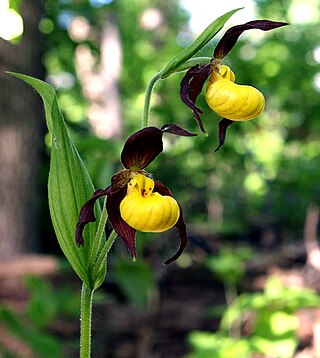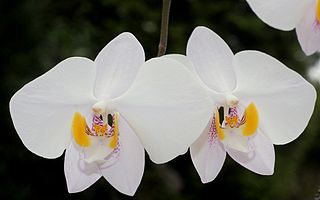
Anacamptis morio, the green-winged orchid or green-veined orchid, is a flowering plant of the orchid family, Orchidaceae. It usually has purple flowers, and is found in Europe and the Middle East.

Paphiopedilum armeniacum is a species of flowering plant in the orchid family, Orchidaceae. It is known commonly as the apricot orange paphiopedilum and golden slipper orchid. It is endemic to China, where it occurs only in Yunnan. It is also cultivated and has won prestigious awards at flower shows.

Paphiopedilum rothschildianum, commonly known as the Gold of Kinabalu orchid or Rothschild's slipper orchid, is a large sized clear-leafed species of orchid. It blooms with a tall inflorescence with up to six, large flowers. It is unique in the Corypetalum group by holding its petals almost horizontally, giving the flower a very distinctive appearance. The peak flowering period is from April to May.

Paphiopedilum glaucophyllum, common name shiny green leaf paphiopedilum or tropical lady's-slipper, is a species of flowering plant in the genus Paphiopedilum of the family Orchidaceae.

Paphiopedilum barbigerum is a species of flowering plant in the family Orchidaceae known commonly as the beard carrying paphiopedilum. It is native to China, Vietnam, and Thailand. It is an endangered species due to habitat destruction and overcollection for the horticultural trade.

Paphiopedilum dianthum is a species of flowering plant in the orchid family, Orchidaceae. It is native to China, Laos, and Vietnam. It is known commonly as the double flowered paphiopedilum.

Paphiopedilum fowliei is a species of plant in the family Orchidaceae. It is endemic to Palawan in the Philippines. Its natural habitat is subtropical or tropical moist lowland forests. It is threatened by habitat loss.

Hammarbya paludosa is a small orchid commonly known as bog orchid, bog adder's-mouth or bog adder's-mouth orchid. It grows in bogs in temperate and subarctic regions of the Northern Hemisphere.

Cattleya aclandiae, or Lady Ackland's cattleya, is a species of orchid from the genus Cattleya, named in honor of Lady Lydia Elizabeth Ackland, wife of Sir Thomas Dyke Acland, 10th Baronet who was the first European to grow the plant successfully. The illustration of the plant which accompanied its first description was based on a drawing by Lady Ackland. The genus was named in honour of William Cattley, a prominent British merchant and horticulturist.

Cypripedium parviflorum, commonly known as yellow lady's slipper or moccasin flower, is a lady's slipper orchid native to North America. It is widespread, ranging from Alaska south to Arizona and Georgia. It grows in fens, wetlands, shorelines, and damp woodlands.

Paphiopedilum insigne is an Asian species of slipper orchid and the type species of the genus Paphiopedilum. Its name is derived from the Latin insigne, meaning 'badge of honor' due to the magnificent flower. In the 19th century it was very popular among European and American orchid growers, causing it to become very rare in the wild due to over collecting. There are many varieties of it and hybrids with it.

Paphiopedilum sanderianum is a rare species of orchid endemic to northwestern Borneo. First discovered in 1885 by F. Sander's collector, J. Foerstermann, the orchid became renowned for the remarkable length of its petals, which can measure over 1 meter long. Although P. sanderianum has been used as a parent in a number of crosses, none of the resulting hybrids have so far matched the extraordinary lengths of this species' petals. However, soon after the turn of the 20th century, this rare orchid was lost to cultivation and thought to be extinct in the wild, until its rediscovery in 1978 by Ivan Nielson. The wild population of Paphiopedilum sanderianum grows protected in Gunung Mulu National Park.

Phalaenopsis philippinensis is an endemic species of orchid found from Luzon island in the Philippines.

Restrepia guttulata, commonly called the small-spotted restrepia, is a species of orchid occurring from Venezuela to Ecuador.

Paeonia delavayi is a low woody shrub belonging to the peonies, that is endemic to China. The vernacular name in China is 滇牡丹. In English it is called Delavay's tree peony, Delavay peony, Dian peony, and dian mu dan. It mostly has red brown to yellow, nodding flowers from mid May to mid June. The light green, delicate looking deciduous leaves consist of many segments, and are alternately arranged on new growth.

Ericksonella saccharata, commonly known as sugar orchid, is the only species in the genus Ericksonella in the orchid family, Orchidaceae, and is endemic to the south-west of Western Australia. It has a single leaf and a single flower with three white sepals and two similar petals.

Schoenocrambe barnebyi is a rare species of flowering plant in the mustard family known by the common names Barneby reed-mustard, Syes Butte plainsmustard, and Barneby thelypody. It is endemic to Utah in the United States, where it is known only from Emery and Wayne Counties. It is threatened by habitat degradation and destruction. It is federally listed as an endangered species of the United States.

Liparis liliifolia, known as the brown widelip orchid, lily-leaved twayblade, large twayblade, and mauve sleekwort, is a species of orchid native to eastern Canada and the eastern United States. It can be found in a variety of habitats, such as forests, shrublands, thickets, woodlands, and mountains. The orchid is considered globally secure, but it is considered rare or endangered in many northeastern states.
Caladenia colorata, commonly known as coloured spider-orchid, small western spider-orchid and painted spider-orchid is a plant in the orchid family Orchidaceae and is endemic to South Australia and possibly Victoria. It is a ground orchid with a single hairy leaf, and usually a single creamy-green flower with blood-red or purple-brown markings and with dark tips on the petals and sepals.

Orchis pallens, the pale orchid or pale-flowered orchid, is a perennial herbaceous plant belonging to the genus Orchis of the family Orchidaceae. It is found in most of Europe ranging from Spain across to the Caucasus. It blooms in spring with pale yellow flowers.



















